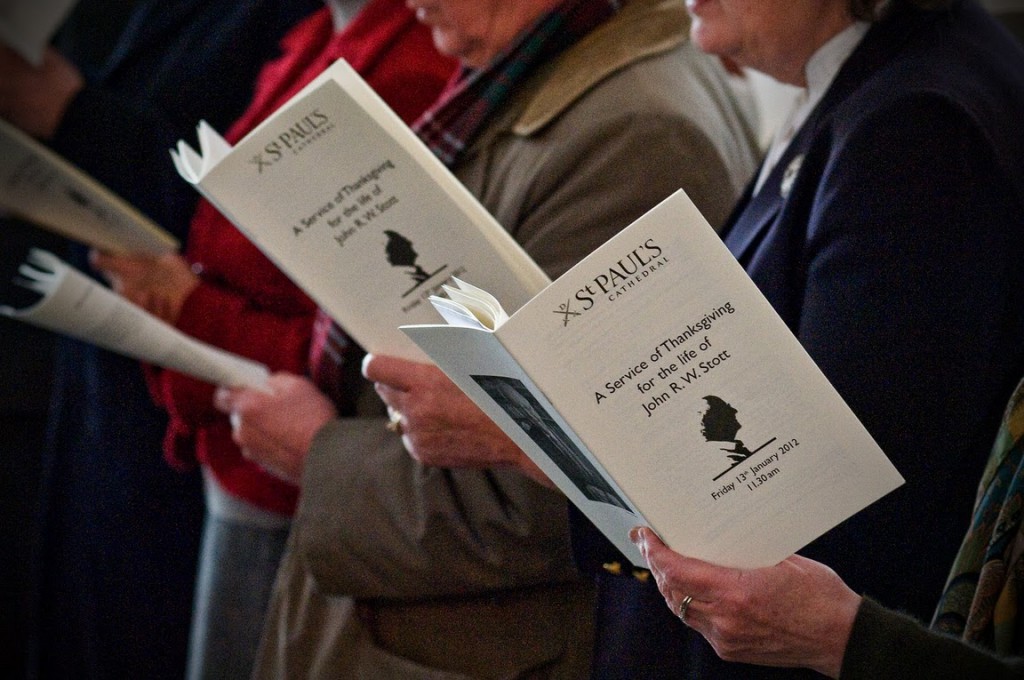This year we commemorated the 100th anniversary of the birth of John Stott. The publishers of his books, The Gospel Coalition, and Christian Today were among those celebrating Stott’s influence and emphasizing, in remarkably similar ways, that evangelicals still need to learn from Stott. They particularly recognize his effectiveness as an irenic but principled evangelical, one who sought to build bridges and who drew lines of division only where Scripture required it.
I have also wanted to recognize John Stott on this occasion, but I find that I have nothing better to say than what I wrote in 2011 for the booklet distributed at the Service of Thanksgiving for the Life of John W. Stott in London’s St. Paul’s Cathedral with 2000 invited guests from all over the world. I never saw so many Anglican and other bishops attending the farewell service of a simple priest. It was one of the most impressive services I ever visited and “The Cross” – the title of Stott’s major work, stood in the center of it.

Here is that message, with only minor updating:
John Stott: Man of Complementarity
John Stott, the main author of the theological preamble of the constitution of the World Evangelical Alliance and a key player in the launching of our theological journal, the Evangelical Review of Theology, is now with Jesus, who was the focus of his life in all he did, said and wrote. In what was probably his best book, The Cross of Christ (1986), he summarized his legacy to all evangelicals when he stated that only if the cross of Jesus remains our center can we achieve unity.
For me, John Stott is a role model for all evangelical theologians. He was an impressive master of complementarity, by which I mean that he was never willing to emphasize one important thing at the expense of other important things. Let me illustrate some of those complementarities by comparing John Stott to Paul—something he surely would have very much disliked!
- Like Paul, Stott was a pastor, a missionary and a great theologian at the same time. His academic theology was always aimed at the body of Christ, not his academic colleagues.
- Like Paul, he was a master thinker and systematic writer, trying to put the whole faith into one short book (Romans for Paul, the 1958 classic Basic Christianity for Stott). And yet he never wrote in an abstruse way so as to impress academics, but so that the whole church could benefit.
- Like Paul, he was willing to strive for the gospel and was a man of clear words; see especially his Christ the Controversialist (1970). And yet he was a man of peace, a bridge builder, someone who listened to other opinions very thoroughly and sought to understand them. Through his involvement in the WEA and the Lausanne Movement, he brought evangelicals and evangelical theologians together on a larger scale than ever before. But he did not do so by having no principled position or by bypassing theological discussion or biblical exegesis. Rather, he brought people together in the midst of theological debate. He was convinced that unity would not come from doing less good theology, but from more open study of the Bible together across all lines.
- Like Paul, he was as local as he was global. He managed to write, speak and travel all over the world while also being totally dedicated to personal counseling, to his local congregation and to the mentoring of those close to him.
- Like Paul, Stott became world-famous and yet remained a humble servant who never understood how Jesus could use him in such a way.
- Like Paul, he became prominent in politics and the secular world and stood before rulers—for example, preaching to the Queen and being counted among the 100 most influential people by Time magazine in 2005. And yet he was never absorbed by this worldly influence; rather, preaching the gospel stayed his obsession.
- Like Paul, he was a master of the old and brilliant with regard to what needed to be changed and invented anew. He never wanted to conform the old rugged cross to the modern age, but to defend the faith once for all given to the church. And yet he was open to adapting the Christian faith to ever-changing situations on all continents, even in his old age. As a young man, his evangelical gospel looked very old to some; as an old man his ideas seemed fresher than those of many people 60 years younger than he.
- Like Paul, Stott was convinced that preaching the gospel is the center of everything, but at the same time he furthered works of compassion to the needy worldwide. He saw everything through the lens of the gospel, knowing that only the cross can overcome the sins of pride, racism, mammon, hatred, sexual abuse, and so on, yet at the same time he motivated many people to become engaged in opposing those social evils.
- I hope that the World Evangelical Alliance can maintain John Stott’s high standards and carry his theological heritage into the future of the evangelical movement.
